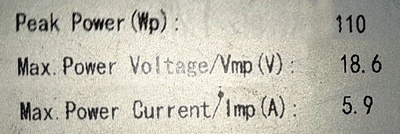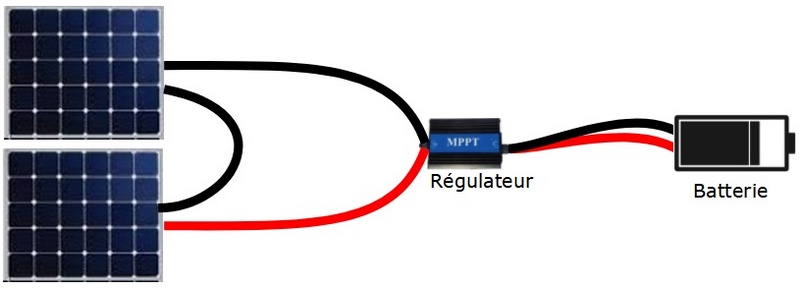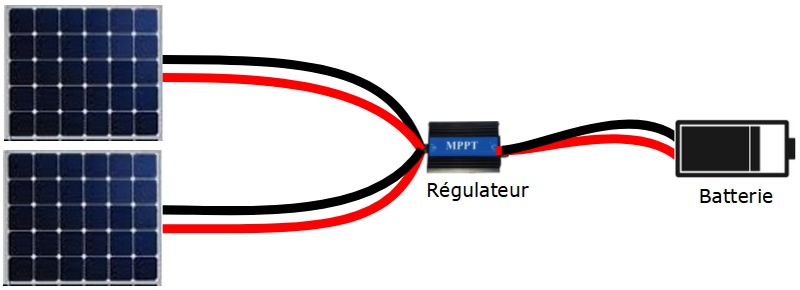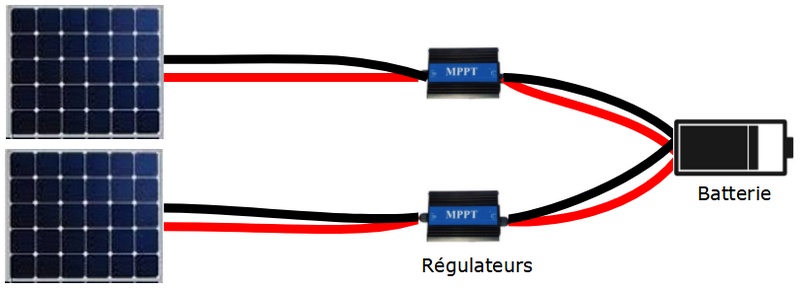Principles
The electrical energy by a photovoltaic panel varies according to the sunshine. However, charging a battery requires an electrical voltage adapted to this battery. It is therefore not possible to directly connect a solar panel to a battery.
The panel is connected via a solar charge controller whose role is to adapt and limit the charging voltage (in Volts) to a battery. Depending on the amount of energy provided by the sun, the regulator varies the charging current (in Amps). If there is a lot of sun, the current will be high and the charge will be faster.

N.B.: We will only talk here about the Boost-type regulators that are the most common among solar cyclists. These regulators require that the output voltage of the panel be lower than the nominal voltage of the battery.
The characteristics of a solar controller
The technical sheet of a solar controller mentions its characteristics:

- the maximum permissible input voltage, in Volts (V)
- the maximum input current in Amperes (A)
- the maximum input power (Watt peak: Wc / Wp in English)
- the nominal output voltage that corresponds to the nominal voltage of a battery (for example 36V or 48 Volts).
The characteristics of a solar panel
On the label affixed to the back of the panel, the manufacturer specifies the characteristics of the panel. Here are the useful specifications for our purpose:
- the maximum current at maximum power / Imp in English (in Amps: A)
- the maximum voltage at maximum power / Vmp in English (in Volts: V)
- maximum power / Wp in English (Watt peak = Wc)


These are the maximum values reached when the sunshine and temperature conditions are optimal. By convention these values are given for a power received from the sun at the perpendicular of 1000W/m² and a panel temperature of 25°. These values are almost never reached either because of the poor transparency of the air, or because of the heat, or both…
Connection of 1 solar panel to 1 controller
Before connecting a panel to a solar charge controller, it should be checked whether the value of each parameter of the solar panel (voltage, current, max power) is lower than that of the corresponding parameter on the controller.

In the example above, the parameters of a panel of 6 x 8 = 48 cells were compared to those of a standard regulator. It is observed that each value of the panel is less than the corresponding value of the regulator.
Connection of 2 identical solar panels
We can imagine three different ways to charge a battery with 2 solar panels:
- Connecting panels in series, with 1 load controller
- Connecting the panels in parallel, with 1 load controller
- Connection of each panel with its own charge controller, i.e. 2 regulators in all
Connecting panels in series

Connecting panels in parallel

Connecting panels with 1 regulator per panel

With panels of different characteristics, this is the only configuration to implement.
Limits according to the characteristics of the panels
We will see in the tables below that, depending on their characteristics, some combinations are not possible.
Combination of 6×5=30 cell panels ((Vmp=18.4 V; imp=5 a; P=95Wc)

We see that in the parallel configuration, the max current at the outlet of the panels is at the permissible limit at the input of the regulator. This configuration should be avoided as a security measure.
Combination of 8×4=32 cells panels (Vmp=19.6V; imp=5.3A; P=100Wc)

We see that in the parallel configuration, the max current at the exit of the panels exceeds the limit at the input of the regulator. In case of strong sunlight, the fuse of the regulator will melt to protect the circuits.
Combination of panels of 6×6=36 cells (Vmp=22V; imp=6A; P=130Wc)

We see that in the parallel configuration, the max current at the exit of the panels exceeds the limit at the input of the regulator. In case of strong sunlight, the fuse of the regulator will melt to protect the circuits.
Combination of 6×8=48 cells panels (Vmp=29.4V; imp=8A; P=170Wc)

We see that in this configuration:
– in parallel, the max current at the output of the panels exceeds the limit, – in series, the max voltage at the output of the panels is too high, – in series or in parallel,
the max power is exceeded.
There is no other solution than to install 1 regulator per panel.
Conclusion
This article aims to show that the choice of panels, the number of panels, the way to connect them are closely related. We will develop in a future article the relationship between the nominal voltage of the battery (36 V, 48V, 52V …), the choice and organization of panels.
